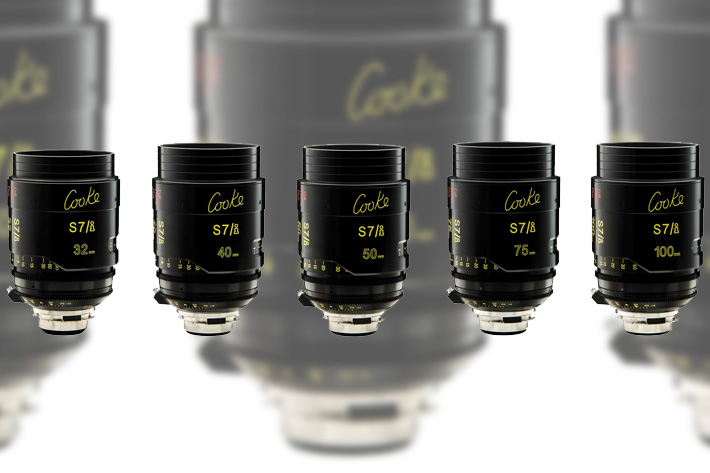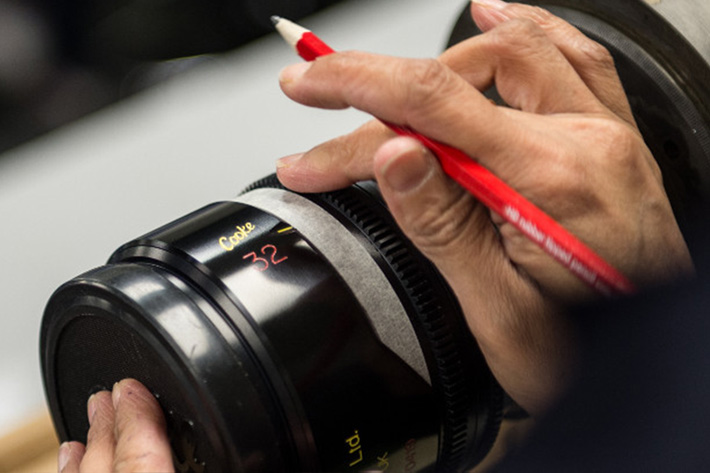
Cooke Optics, Panavision, RED Digital Cinema, Canon, Blackmagic Design, CW Sonderoptic, and Sony take steps to officially standardise lens metadata on /i Technology protocol at the same time Cooke Optics introduces the new S7/i lenses.
Scheduled to ship from June 2017, the new S7/i Full Frame Plus prime lens range is designed to cover the emergent full frame cinema camera sensors, up to the full sensor area (46.31mm image circle) of the RED Weapon 8K. The new lenses – which, like all Cooke lenses, feature the beloved ‘Cooke Look’ – will be available in 18, 25, 32, 40, 50, 75, 100 and 135mm.
All Cooke S7/i Primes have a true T2.0 aperture and cover 35/Super 35mm, Full Frame and beyond. They have a common fixed front diameter of 110mm, with a focus drive gear of 140T x 0.8 mod and an iris drive gear of 134T x 0.8. A nine-leaf linear module iris assembly is fitted into the Cooke S7/i lenses. The average weight of an S7/i lens is approximately 3.5kg.
“The Cooke S7/i Full Frame Plus range enables you to shoot beautiful 35mm/Super 35mm format now, and also to be prepared when camera sensors go to full frame, VistaVision and beyond,” said Les Zellan, Chairman and Owner, Cooke Optics.
Cooke will also debut the Panchro/i Classic range and the new front Anamorphic/i zoom lens at NAB 2017. In addition, visitors to the Cooke booth will see the Anamorphic/i SF lens range, as well as lenses from its leading Anamorphic/i, 5/i, S4/i and miniS4/i ranges, and the Sony E and micro 4/3 mounts for miniS4/i and Panchro/i Classic lenses that enable users of these cameras to benefit from the ‘Cooke Look’ for the first time.
The /i Technology protocol present in lenses from Cooke Optics is now about to become very important when it comes to lens metadata, as Panavision, RED Digital Cinema, Canon, Blackmagic Design, CW Sonderoptic and Sony are embracing an industry-defining project to standardise the collection of lens metadata from PL and selected Panavision mount lenses on the /i Technology protocol.

The /i Technology is a metadata protocol that enables film and digital cameras to automatically record key lens data for every frame shot. Equipment identification is by the serial number and lens type. Metadata includes focal length, focus distance, zoom position, near and far focus, hyper focal distance, T-stop, horizontal field of view and entrance pupil position. Data is recorded in either metric or imperial and can be selected for either format. The information is digitally recorded for every frame, at any frame rate up to 285 fps and is stored as metadata. Human error is eliminated because there is no longer a need for the script supervisor to manually write down lens settings for every shot.
While the value of metadata is a given for archiving, it is still largely overlooked at the acquisition stage. Cooke Optics – which has over 130 years of experience in lens development and a Scientific and Technical Academy Award among many other industry accolades – recognised this deficit in lens metadata capture around 17 years ago, and set out to create a metadata protocol that would provide the industry with a digital open standard to gather and share lens data, ensuring compatibility from acquisition to post-production. The result was /i (Intelligent) Technology.
Today there are 30 /i Technology partners, including many of the industry’s leading camera, lens, monitoring, data recording and post-production manufacturers, which support /i Technology in their products. However, up to now there has been no standard for lens metadata.
“Today’s announcement has been a very long time in the making, but we are proud to take this significant step with our friends at Panavision, RED, Canon, Blackmagic, Design, CW Sonderoptic, and Sony to recognise /i Technology as an industry-wide standard language for metadata from PL mount lenses,” said Les Zellan, Chairman and Owner, Cooke Optics. “Our goal has always been to give /i to the wider industry, in order to provide film-makers and post-production teams around the world the crucial lens data they need, in a format that is universally recognised. This collaboration takes us a big step closer to achieving that goal.”
“The /i lens metadata originates at the lens, which is most upstream and can be used at all steps throughout the workflow. Here at Panavision, we provide end-to-end solutions (lens to camera to post) to our filmmakers where the /i becomes a key component in the workflow we offer,” said Haluki Sadahiro, Director, New Product Development, Panavision.
Jarred Land, President, RED Digital Cinema, said, “Since our inception RED has valued the importance of lens metadata and we have supported /i data since our very first camera, the RED ONE. We are very pleased that the industry, both lens manufacturers and camera manufacturers, have come together to embrace /i as a common standard with the goal of making metadata workflow as coherent as possible. We congratulate the entire Cooke team on advancing their /i technology and look forward to continuing support for /i in our current and future cameras.”
Hiroo Edakubo, Group Executive of Video and Lens Product Group, Canon Inc., said, “Canon has long understood the importance of lens metadata and implemented this in the broadcast 2/3-inch B4 mount lens many years ago. It is a natural progression to seek a similar solution for our PL cinematography cameras and lenses.”
“The combination of URSA Mini Pro 4.6K cameras with PL lenses that use the /i Technology is extremely powerful,” said Grant Petty, CEO, Blackmagic Design. “It’s exciting because customers can use the lens metadata throughout the entire production process when they shoot and then edit, color correct and finish projects with DaVinci Resolve, or when creating visual effects with Fusion.”
“At CW Sonderoptic we have had lens metadata in our sights for a long time,” said Gerhard Baier, Managing Director, CW Sonderoptic. “With the introduction of our new large format, character-driven Leica Thalia lenses, we are excited to incorporate Cooke’s /i Technology to answer the call of filmmakers and post production supervisors around the world for a metadata system within Leica cine lenses.”
Yasuo Ueda, Senior General Manager, Business Unit 2 (Professional Camcorder and Cinema Camera System), Sony Imaging Products & Solutions Inc, said, “Sony has always been at the forefront of advancing workflow efficiency within the content creation industry. Our engineering teams are proud of their work in defining file format metadata standards and signal interfaces. Without doubt, lens metadata is becoming increasingly important to digital cinematography workflows.”
The development of /i is ongoing thanks to input from the /i Technology partners, with data, technology and methodology freely available to all partners to use for their own refinements. Recent developments include a complete camera and lens communication system similar to that which is available for 2/3” broadcast cameras; inertial tracking that helps VFX teams to better deal with common issues like occlusions and fast camera motion (motion blur); and unique distortion mapping for individual lenses, as opposed to a theoretical measurement of all lenses of a particular focal length.
The long-term goal for the /i standard is to ensure it evolves with the changing metadata requirements on-set and in post, while also respecting the ever-growing technical requirements of the /i Technology partners, and paying attention to relevant industry developments.

